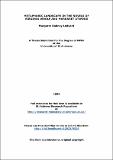Files in this item
Metaphoric landscape in the novels of Virginia Woolf and Margaret Atwood
Item metadata
| dc.contributor.advisor | Mallett, Phillip | |
| dc.contributor.author | Ledyard, Margaret Dabney | |
| dc.coverage.spatial | viii, 144 p. | en_US |
| dc.date.accessioned | 2016-11-16T12:44:13Z | |
| dc.date.available | 2016-11-16T12:44:13Z | |
| dc.date.issued | 1994 | |
| dc.identifier.uri | https://hdl.handle.net/10023/9826 | |
| dc.description.abstract | The purpose of the following study is to demonstrate the metaphoric landscape as a tool to delineate boundaries in their novels. The thesis will explore the progression of this technique from Woolf to Atwood to discover whether these two novels can be read in similar ways, "suggesting" as Avril Horner and Sue Zlosnik remark, "a continuing tradition of alternative quest and vision in women's writing." The first part of the thesis introduces metaphoric landscape and illustrates the various ways that Woolf and Atwood use the technique. biographical sketch of Woolf, and it closely examines five of the author's novels as well as one of her essays. Part III introduces Atwood to the study with a brief historical background and a comparison with Woolf; it also explores the technique as it appears in seven of Atwood's novels. The dissertation concludes with observations that connect Parts II and III, showing the way that Woolf and Atwood delineate existing boundaries and forge new frontiers through their use of metaphoric landscape. | en_US |
| dc.language.iso | en | en_US |
| dc.publisher | University of St Andrews | |
| dc.subject.lcc | PR6045.O72Z5L3 | |
| dc.subject.lcsh | Woolf, Virginia, 1882-1941 | en_US |
| dc.subject.lcsh | Atwood, Margaret, 1939- | en_US |
| dc.title | Metaphoric landscape in the novels of Virginia Woolf and Margaret Atwood | en_US |
| dc.type | Thesis | en_US |
| dc.type.qualificationlevel | Doctoral | en_US |
| dc.type.qualificationname | MPhil Master of Philosophy | en_US |
| dc.publisher.institution | The University of St Andrews | en_US |
This item appears in the following Collection(s)
Items in the St Andrews Research Repository are protected by copyright, with all rights reserved, unless otherwise indicated.

